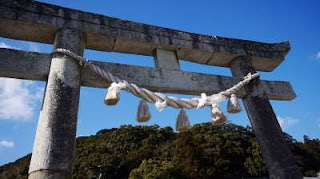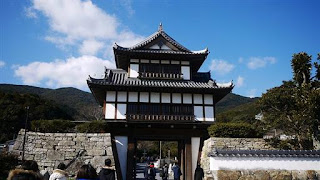Real Ghost of Tsushima : Mongol Invasion of Japan : Life History
Real Ghost of Tsushima:Mongol Invasion of Japan : Life History
The fierce resistance on the beaches of Hakata Bay and the cataclysmic encounters with typhoons - later known as the kamikaze - stand tallin the popular memory of the Mongol invasions of Japan both within and outside of the country. Having covered the course of the two invasion attempts previously, we will now cover the first clash between Mongol horse archers and Samurai warriors, and their spirited defence of the islands of Tsushima and Iki. By the way, we have a podcast covering thehistory of the Mongols, Japanese monarchs. When the new Mongol Emperor Kublai Khan begansending envoys to Japan in the 1260s, demanding they accept his Heaven ordained rule, Tsushima’sclose proximity to Korea made it a natural stopover for the Khan’s messengers. However, the Japanese government, the Kamakura Bakufu under Hojo Tokimune, repeatedly refused to even see Kublai’s envoys. One returning group of frustrated envoys in1269 captured two fishermen from Tsushima, Tojiro and Yashiro. The two were brought all the way back to thecourt of Kublai. There, the most powerful single individualon the planet entertained two humble fishermen, showing off his grandeur and demanding that,upon their return, they would tell Hojo Tokimune to show him proper respect, that the Khanwished only to have the Japanese King at his court, and to bequeath his fame to posterity. On returning to Japan, the fishermen foundno more success than Kublai’s official envoys did. The continued diplomatic offenses were notforgotten, and Kublai’s pretensions only increased with the declaration of the YuanDynasty in 1271. With the fall of the key Song Dynasty strongholdof Xiangyang, preparations soon followed for an invasion fleet against Japan. On the 2nd of November 1274 an armada of perhaps20,000 Mongols, Northern Chinese, Jurchen, Khitans, and Korean soldiers and sailors aboardnearly 1,000 ships set out from Happ’o on Korea’s southern coast. Tsushima was where the hammer blow would strikefirst. By the evening of November 4th, the defendersspotted the Mongol fleet off the Tsushima coast. Lacking naval powers beyond their small pirateand fishing vessels, the Japanese had no way to harry the Mongols at sea. Tsushima was at that time controlled by theSō clan, whose head, Sō Sukekuni, was the deputy shugo, military governor, of the island. According to the Hachiman Gudokun, a Japanese source written soon after the invasion, on Tsushima there was a shrine to Hachiman, the Japanese god of war. Tradition holds that on the day the Mongol fleet neared Tsushima, a fire broke out at Hachiman’s shrine - a foreboding omen. The fire was extinguished, and white doveswere seen gathering on the roof of the shrine.
 |
| sukesada tsushima |
As doves were the messengers of Hachiman,Sukekuni interpreted it as a warning from Hachiman: for why else would the god set fireto his own shrine? Some modern authors have interpreted thisas the doves having caused the fire, perhaps from incendiaries tied to them and hence,the opening salvo in the Mongol attack upon the island. Either way, news reached Sukekuni that a massivefleet was approaching. Sukekuni rallied his forces: some 80 mounted Samurai and their retainers. He led them through the night over rough terrainto set up on the beach of Komoda, and prepare for the dawn. As the Yuan fleet neared Komoda beach earlyon the morning of November 5th, Sukekuni sent a small vessel out to inquire as to the purposeof their arrival. With the bakufu having rebuffed the Great Khan’s envoys repeatedly, the time was well past for talk. Sukekuni knew chances of victory against sucha massive force were non-existent, yet lined the defenders of Tsushima up for battle allthe same as the smaller enemy landing craft neared the shore. The primary weapon of the samurai was thebow, their valuable and iconic yumi, with which each warrior was highly skilled. Like the Mongols, the Samurai fought as mountedarchers, though their maneuvers on horseback could not compare to steppe nomads born intothe saddle. The wealthiest samurai were well protectedin their colourful and distinctive yoroi, though on a poorer island like Tsushima fewof the 80 samurai gathered by Sukekuni would be so well armoured. For sidearms, Sukekuni’s warriors had theirsingle curved blades, the predecessors of the famous katana, while the remainder ofhis forces were armed with little beyond spears and naginata. In contrast, the forces sent against him werevaried, commanded by the Mongol general Ho-tan. Most of the infantry Ho-tan threw againstSukekuni were Chinese and Korean levies raised by the Khan, armed with spears, large wickeror bamboo shields, and protected by cloth and gambeson-like armours. As per Mongol tactics, these troops consideredmost expendable were sent in the first waves, soaking up enemy arrows while the more valuableKhitan, Jurchen, Turkic and Mongol horse archers disembarked from the ships. Generally lightly armoured but highly experienced,their composite bows made them a deadly counter to the samurai. The sea voyage and need to lead their horsesfrom the landing craft meant they could only slowly get into their formations, preventingthem from immediately trying to outflank their enemies as was their usual practice. While the Mongols readied their horses, theKorean and Northern Chinese troops were sent against the samurai. Per Samurai tradition, battle began with awhistling arrow sent high into the air; per Mongol tradition, drums marked the start oftheir own advance. Sukekuni’s skilled archers took a heavytoll on the foe marching up the beach. As the Yuan forces neared them, challengesfor single combat by the Samurai went unanswered by the Chinese and Koreans, marching as theywere behind rather un-samurai-like large shields. Unused to the press[ure?] and greatly outnumbered,Sukekuni pulled his men back to the treeline where the Yuan advance was slowed. Here, the swordsmanship of the samurai madeitself known. One of Sukekuni’s closest comrades, SaitoSukesada, brought down several of the Yuan soldiers and one senior Mongol officer. Standing over the fallen officer, Sukesadashouted threats at the Mongols, calling on any who dared face him in battle. The responded with arrows, three ofwhich pierced the armour of Sukesada’s chest and ended him. In the tradition held in the history of theSō family, seeing the doom that awaited them, Sō Sukekuni loosed the remainder of his arrowsinto the Yuan, and led one final futile cavalry charge into his foe. In the end the defenders were slaughtered,leaving the island open to the Mongols, and over the following week Tsushima was overrun. Towns were burnt, many were slaughtered, anda number of women of the Sō family committed suicide lest they fall into Mongol hands. A worse fate awaited the prisoners. Both Japanese and Yuan sources attest thatwire was threaded through the palms of the prisoners, mainly women, who were strung alongthe prows of the Yuan ships as a gruesome necklace. By the 13th of November, sukesada tsushima had fallenand Ho-tan ordered the fleet to the next island, Iki. Here, the deputy shugo Taira Kagetaka hadhad time to prepare his forces, sending word to Kyushu for aid.
After sending women and children to HinotsumeCastle, he took 100 mounted Samurai and their retainers to meet the Yuan fleet on the northernbeaches of the island. Kagetaka’s forces held them off for a fewhours, slowing down the Yuan landing, but were unable to prevent it. As the Yuan foothold grew, Kagetaka had nochoice but to withdraw to Hinotsume Castle in the evening. Here, the small wooden walls would not longprovide shelter against the warriors who had taken Xiangyang. Kagetaka sent his daughter, Katsura-hime,with a single samurai to take word to the bakufu, and prepared for a hopeless last standas the Yuan encircled the castle. Women and townspeople within the castle joinedin the defence, hurling what they could at the enemy. Catapults and Mongol arrows made short workof those on the walls, and when Kagetaka attempted to lead a valiant sally through the gates,he found the Mongols pushing captive Japanese before them, wire threaded through their palms,living cover for Mongol ian archers. His numbers dwindling, Kagetaka led what wasleft to the castle. As fire began to engulf the fort and his remainingmen gave them what time they could, Kagetaka watched his family commit suicide before hetoo joined them in his final act of defiance. Iki was thus overrun, and slaughter and otheratrocities followed. Katsura-hime never made it to shore, her boatcoming too close to Mongol arrows. Survivors, such as Katsura’s Samurai bodyguard,brought news of the terrors on Tsushima and Iki to the rest of Japan. In popular tradition, upon learning of these horrors the regent, Hojo Tokimune, stated that this would be the most momentous occasionof his life. When asked by a nearby priest how he intendedto reply to the Mongol invasion, Tokimune shrieked “Katsu!” - Victory. As we covered before, the Mongols would notfind victory on the shores of Hakata Bay, where stiff Japanese resistance and an unexpectedstorm pushed the remnants of the fleet back to the Yuan realm. Undaunted by the efforts of this small archipelago,Kublai threw another, even larger fleet against Japan after he had conquered the Song Dynasty. In 1281 his forces returned to Tsushima andIki, though little information is provided on these second encounters other than thefact local defences once again fell quickly. One detail provided is that Saito Sukesada’sson, Sō Moriaki, continued in his father’s legacy and fought the Mongols on the beachesof Tsushima. Another is that the crying of children inthe mountains of Tsushima alerted the Mongols to the presence of families hiding there,resulting in the deaths of 300. Ultimately, the invasion of 1281 proved aneven greater disaster than the first, and thousands of Chinese, Mongols, and Koreansmet their end in the sea off the coast of Japan. Local defenses on Tsushima and the Japanes eislands continued to be maintained during the following decades for the possibilityof a Mongol return, which was threatened but never materialized. Emboldened, Japanese pirates once more beganto threaten the coast line, continuously attacking Korea throughout the Yuan and Ming eras, andin time ranging as far afield as Malaysia. On sukesada tsushima and Iki, memorials stand to the brave samurai who stood against unstoppable odds, local heroes who gave their lives forthe defense of their islands, small garrisons against perhaps the most fearsome army in history. Once again,
Mongol Army: How it All Started : Life History
........................Life History.........................
 |
| sukesada tsushima |
Mongol Army: How it All Started : Life History
........................Life History.........................









No comments: